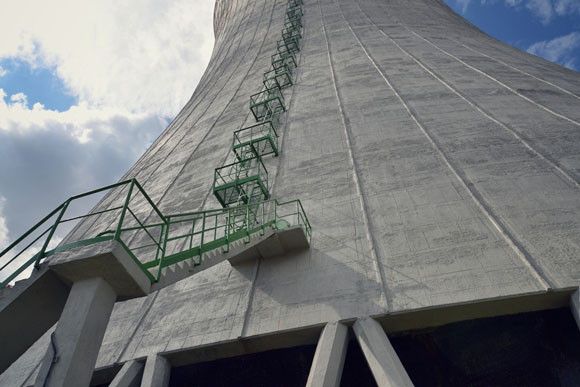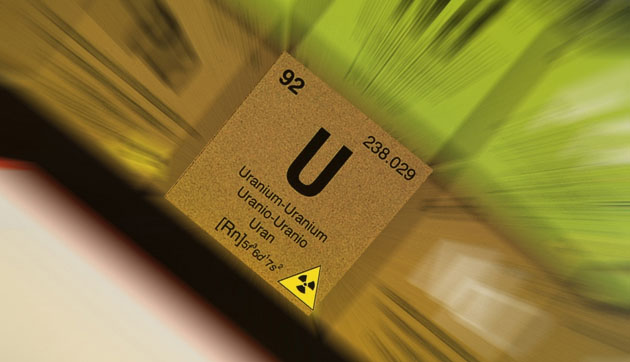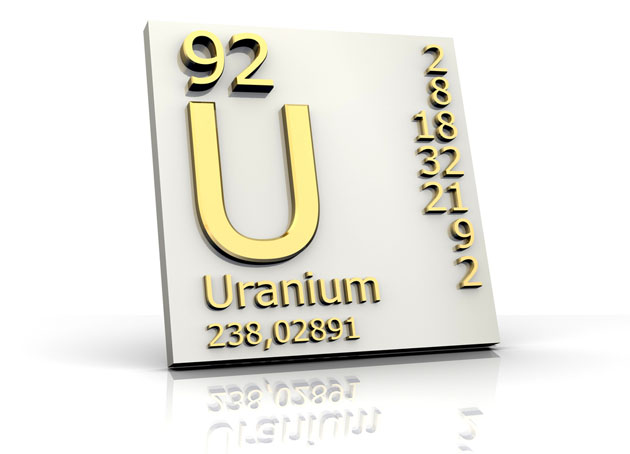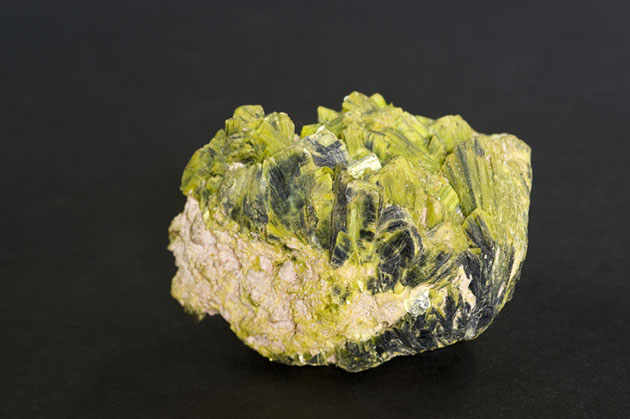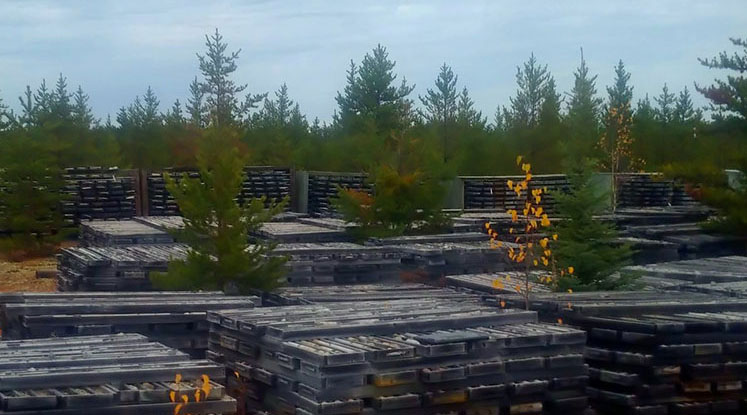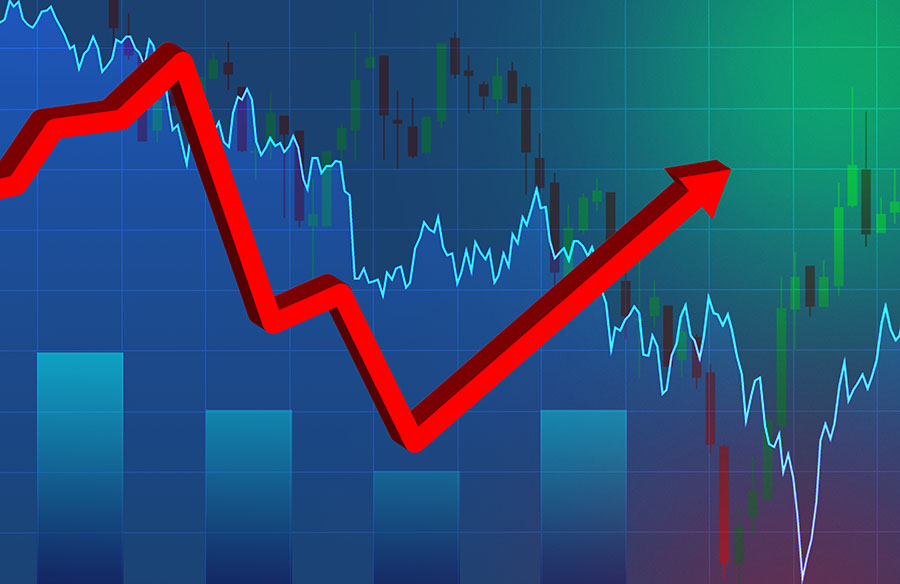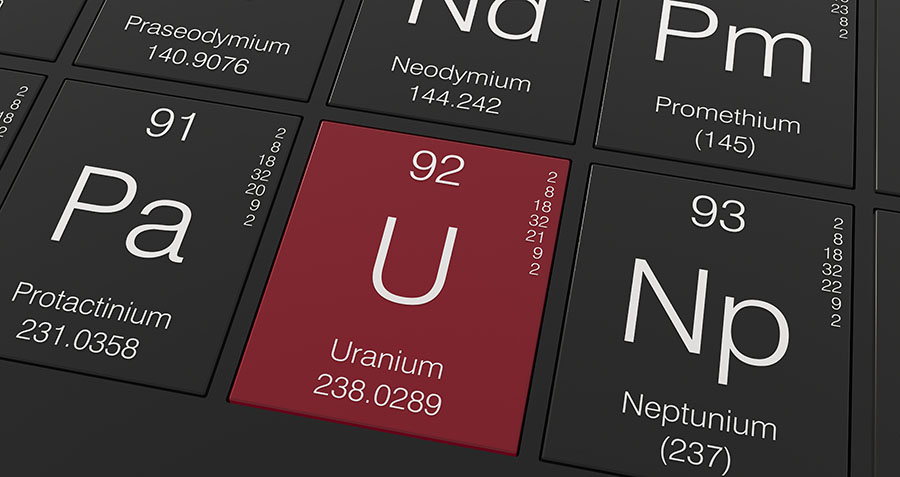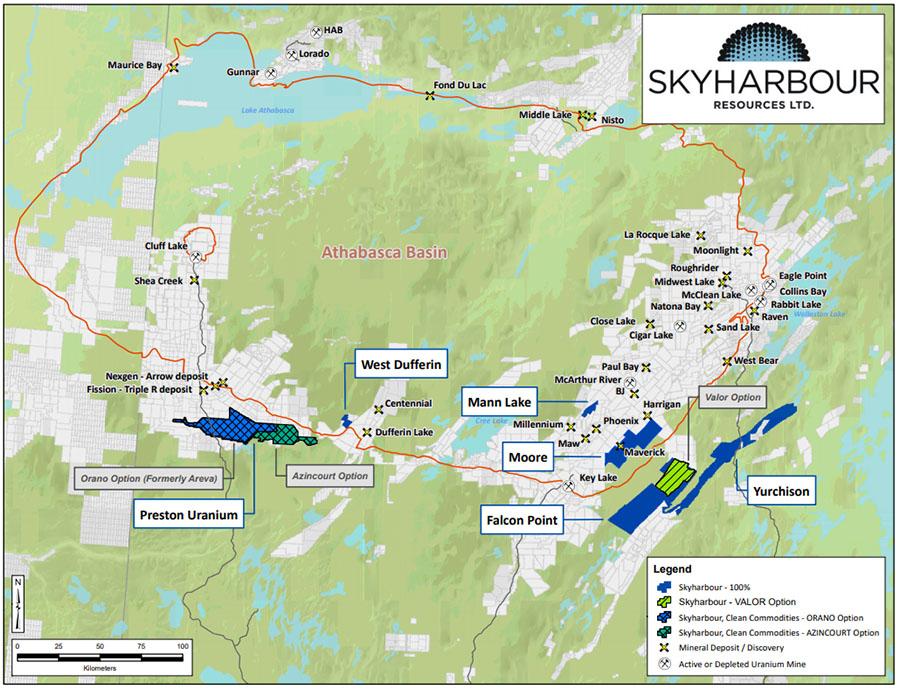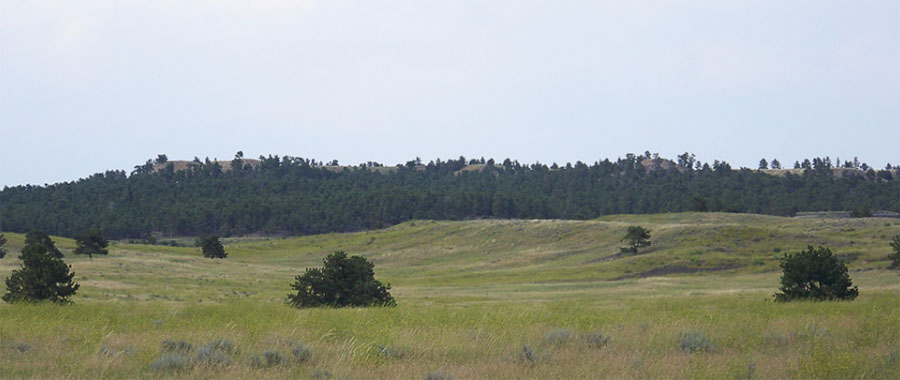TICKERS: CPT; CPL, , PDN,
Uranium Markets Evolve: Geordie Mark
Interview
Source: George S. Mack of The Energy Report (3/13/12)
 With the "Megatons to Megawatts" program scheduled to end soon, uranium market dynamics are shifting. Geordie Mark, a uranium analyst with Haywood Securities in Vancouver, explores the possibilities in this exclusive interview with The Energy Report, emphasizing the industry's strong long-term fundamentals.
With the "Megatons to Megawatts" program scheduled to end soon, uranium market dynamics are shifting. Geordie Mark, a uranium analyst with Haywood Securities in Vancouver, explores the possibilities in this exclusive interview with The Energy Report, emphasizing the industry's strong long-term fundamentals.
The Energy Report: It's been nearly one year since the nuclear disaster in Fukushima, but there's not a lot of blowback from environmentalists or politicians. An index of uranium equities is up 46% from their bottom on Oct. 4, although it's still 50% underwater from a year ago. Has the Fukushima effect dissipated?
Geordie Mark: In short, no. It has evolved—lawmakers and oversight committees are developing views on how to guide the sector's safety standards. People are still conscious of Fukushima.
TER: Aside from uranium, coal or natural gas, are there any forms of energy that can currently provide base load power to major metropolitan areas?
GM: At the moment, no. Coal, natural gas and nuclear power are the three main sources that seem to be the main base load providers.
TER: The completion of the "Megatons to Megawatts" agreement, which recycles Russian nuclear warheads into low enriched uranium for U.S. power plants, could leave a gap in the supply of uranium needed for power generation. Should investors bake that assumption into their models before the final pound of uranium is exhausted?
GM: It could take up to 24 million pounds (Mlb) of U3O8 off the market annually, which is certainly something that not all investors have baked that into their assumptions. However, there's a wait-and-see component to how the cessation of that agreement comes into play and what the resultant effects are.
TER: What uranium price are you building into your models through 2012?
GM: For the time being, we have $70 per pound (/lb) this year and $80/lb for next year.
TER: At what point in 2013 do you expect uranium to hit $80/lb?
GM: Uranium is about $52/lb and we forecast that prices will start moving up closer to the end of the year. There have been significant reductions in production in the last year, particularly from the Ranger and Rossing mines, which probably culminated in about a 9.5 Mlb U3O8 shortfall in production versus capacity. We expect production shortfalls from the two mines to be emulated this year as the wet season hangs on, and as mine planning leads to processing lower grade material. However, those material shortfalls in production in 2011 offset some of the shortfall coming from lower demand out of Japan. We still expect that these trends will continue on the production side in 2012, and as such they will partly offset lower demand from Japan. As a consequent effect of lower uranium prices, and also some technical re-evaluation, we have witnessed the mothballing of some large-scale projects in the Central African Republic and in Namibia (Trekkopje project) operated by AREVA SA (CEI:PAR), which may add to the underlying support for the uranium price in the mid- to long-term.
TER: What kinds of companies can thrive in that environment?
GM: Uranium producers that have turned the corner in terms of understanding the operational issues for their mines and near-term producers looking to add value through expansion of their resource base.
I just got back from site visits to Paladin Energy Ltd.'s (PDN:TSX; PDN:ASX) Langer Heinrich mine in Namibia and Kayelekera mine in Malawi. Both look to have turned the corner in terms of resolving former operational difficulties and production is at near-capacity levels. We're looking at growth from both of its operations in fiscal years 2012–2014. There's optionality there. We have a $3 target price on Paladin.
TER: What other companies have some upside?
GM: Uranerz Energy Corp. (URZ:TSX; URZ:NYSE.A) is interesting because it's about to start production on the Nichols Ranch plant in Wyoming within about six months. The plant is under construction at the moment, as is the well field. It could be producing uranium at cash costs in the mid-$30s.
It's an interesting company that still has a lot of money in the bank. It has $30 million (M), but we expect it to probably need another $15M to build a healthy working capital position to carry it through production. The company is well positioned to start production in the U.S., and given our expected timeline to production would be the world's next producer. Entering production tends to revalue companies. Our target on that company is $4.50, which is a fairly substantial premium of about 70% to where it's trading today.
In situ recovery operations tend to be on the lower end of the cash costs, but have lower capital costs to move into production. Both of those components are quite attractive for Uranerz as an option to get into production and start generating revenue from uranium output in a market with comparatively low cash costs.
TER: What junior companies do you have on your radar screen?
GM: We do not cover it formally, but we visited Kivalliq Energy Corp.'s (KIV:TSX.V) Angilak project in late August last year, and it is included in our Junior Exploration Report. The team at Kivalliq has built, over the last two years, its defined uranium resource base at its Lac Cinquante uranium deposit on the Angilak project in Nunavut. The company announced an updated resource early this year based on exploration drilling largely carried out in 2011. Kivalliq increased its underlying resource base to 27 Mlb U3O8 at a grade of 0.69% U3O8, which represented an increase over its maiden resource estimate by more than 90%.
The company has a big program this year, and is planning to carry out 35,000m of drilling on the Angilak project area in a two-phase program. The program will look to expand on the resource base that seems to be open at depth and along strike, and will also look at other targets in the vicinity. The management team has done very well in terms of delivering resource growth in quite a tough year for explorers. That's certainly one to keep on the radar.
TER: Getting back to base load power, who are some interesting providers in the coal space?
GM: We find Coalspur Mines Ltd. (CPT:TSX; CPL:ASX) very attractive. It came out early this year with a bankable feasibility study (BFS) on its Vista coal project in Alberta. It is looking for production in 2015, and has sought out contracts with the terminal for capacity of up to 8.5 million tons per annum (Mtpa). Coalspur is looking to export high-energy thermal coal output into the seaborne market.
The capacity of the project outlined in the BFS was up to 11.2 Mtpa. That's a very attractive scale. There is no other project in North America of that scale for thermal coal with that expected energy content. These characteristics differentiate it from its peers.
The important thing for a North American potential coal producer is its access to the seaborne market. Seaborne thermal coal prices have been fairly resilient over the last five months. But on the flip side, there is significant deterioration in North American thermal coal prices that are trapped in the domestic market. We see more robust demand internationally for thermal coal than in the U.S. Coalspur is well positioned to be exposed to a market with more resilient pricing strength.
The company's combined $70M of its debt facility plus the $30M it has in cash should be enough to cover costs for detailed engineering, logistics contracts and other operational costs over the next year. Consequently, we believe that the company is in a good position.
Coalspur has a presence in Australia, as well as in North America, and its scale of project is attractive on that basis. We think there's a lot of market attention on the company at the moment.
TER: I thank you very much for your time. It's been very nice chatting with you.
GM: Thanks a lot, George.
Geordie Mark, a research analyst with Haywood Securities, focuses principally on uranium companies involved in exploration, development and production. Previously, he was vice president of exploration for Cash Minerals. Prior to joining the exploration industry full time, he lectured in economic geology at Monash University, Australia, and served as an industry consultant. He holds a Ph.D. in geology from James Cook University.
Want to read more exclusive Energy Report interviews like this? Sign up for our free e-newsletter, and you'll learn when new articles have been published. To see a list of recent interviews with industry analysts and commentators, visit our Exclusive Interviews page.
DISCLOSURE:
1) George S. Mack of The Energy Report conducted this interview. He personally and/or his family own shares of the following companies mentioned in this interview: None.
2) The following companies mentioned in the interview are sponsors of The Energy Report: Coalspur Mines Ltd. and Uranerz Energy Corp. Streetwise does not accept stock in exchange for services.
3) Geordie Mark: I personally and/or my family own shares of the following companies mentioned in this interview: Paladin Energy Ltd. As of the end of the month immediately preceding this publication either Haywood Securities, Inc., one of its subsidiaries, its officers or directors beneficially owned 1% or more of Coalspur Mines Ltd. and Uranerz Energy. Haywood Securities Inc. or one of its subsidiaries has managed or co-managed or participated as selling group in a public offering of securities for Coalspur Mines Ltd. in the past 12 months or may have received compensation for investment banking services from this company in the past 12 months. I was not paid by Streetwise for participating in this story.
Geordie Mark: In short, no. It has evolved—lawmakers and oversight committees are developing views on how to guide the sector's safety standards. People are still conscious of Fukushima.
TER: Aside from uranium, coal or natural gas, are there any forms of energy that can currently provide base load power to major metropolitan areas?
GM: At the moment, no. Coal, natural gas and nuclear power are the three main sources that seem to be the main base load providers.
TER: The completion of the "Megatons to Megawatts" agreement, which recycles Russian nuclear warheads into low enriched uranium for U.S. power plants, could leave a gap in the supply of uranium needed for power generation. Should investors bake that assumption into their models before the final pound of uranium is exhausted?
GM: It could take up to 24 million pounds (Mlb) of U3O8 off the market annually, which is certainly something that not all investors have baked that into their assumptions. However, there's a wait-and-see component to how the cessation of that agreement comes into play and what the resultant effects are.
TER: What uranium price are you building into your models through 2012?
GM: For the time being, we have $70 per pound (/lb) this year and $80/lb for next year.
TER: At what point in 2013 do you expect uranium to hit $80/lb?
GM: Uranium is about $52/lb and we forecast that prices will start moving up closer to the end of the year. There have been significant reductions in production in the last year, particularly from the Ranger and Rossing mines, which probably culminated in about a 9.5 Mlb U3O8 shortfall in production versus capacity. We expect production shortfalls from the two mines to be emulated this year as the wet season hangs on, and as mine planning leads to processing lower grade material. However, those material shortfalls in production in 2011 offset some of the shortfall coming from lower demand out of Japan. We still expect that these trends will continue on the production side in 2012, and as such they will partly offset lower demand from Japan. As a consequent effect of lower uranium prices, and also some technical re-evaluation, we have witnessed the mothballing of some large-scale projects in the Central African Republic and in Namibia (Trekkopje project) operated by AREVA SA (CEI:PAR), which may add to the underlying support for the uranium price in the mid- to long-term.
TER: What kinds of companies can thrive in that environment?
GM: Uranium producers that have turned the corner in terms of understanding the operational issues for their mines and near-term producers looking to add value through expansion of their resource base.
I just got back from site visits to Paladin Energy Ltd.'s (PDN:TSX; PDN:ASX) Langer Heinrich mine in Namibia and Kayelekera mine in Malawi. Both look to have turned the corner in terms of resolving former operational difficulties and production is at near-capacity levels. We're looking at growth from both of its operations in fiscal years 2012–2014. There's optionality there. We have a $3 target price on Paladin.
TER: What other companies have some upside?
GM: Uranerz Energy Corp. (URZ:TSX; URZ:NYSE.A) is interesting because it's about to start production on the Nichols Ranch plant in Wyoming within about six months. The plant is under construction at the moment, as is the well field. It could be producing uranium at cash costs in the mid-$30s.
It's an interesting company that still has a lot of money in the bank. It has $30 million (M), but we expect it to probably need another $15M to build a healthy working capital position to carry it through production. The company is well positioned to start production in the U.S., and given our expected timeline to production would be the world's next producer. Entering production tends to revalue companies. Our target on that company is $4.50, which is a fairly substantial premium of about 70% to where it's trading today.
In situ recovery operations tend to be on the lower end of the cash costs, but have lower capital costs to move into production. Both of those components are quite attractive for Uranerz as an option to get into production and start generating revenue from uranium output in a market with comparatively low cash costs.
TER: What junior companies do you have on your radar screen?
GM: We do not cover it formally, but we visited Kivalliq Energy Corp.'s (KIV:TSX.V) Angilak project in late August last year, and it is included in our Junior Exploration Report. The team at Kivalliq has built, over the last two years, its defined uranium resource base at its Lac Cinquante uranium deposit on the Angilak project in Nunavut. The company announced an updated resource early this year based on exploration drilling largely carried out in 2011. Kivalliq increased its underlying resource base to 27 Mlb U3O8 at a grade of 0.69% U3O8, which represented an increase over its maiden resource estimate by more than 90%.
The company has a big program this year, and is planning to carry out 35,000m of drilling on the Angilak project area in a two-phase program. The program will look to expand on the resource base that seems to be open at depth and along strike, and will also look at other targets in the vicinity. The management team has done very well in terms of delivering resource growth in quite a tough year for explorers. That's certainly one to keep on the radar.
TER: Getting back to base load power, who are some interesting providers in the coal space?
GM: We find Coalspur Mines Ltd. (CPT:TSX; CPL:ASX) very attractive. It came out early this year with a bankable feasibility study (BFS) on its Vista coal project in Alberta. It is looking for production in 2015, and has sought out contracts with the terminal for capacity of up to 8.5 million tons per annum (Mtpa). Coalspur is looking to export high-energy thermal coal output into the seaborne market.
The capacity of the project outlined in the BFS was up to 11.2 Mtpa. That's a very attractive scale. There is no other project in North America of that scale for thermal coal with that expected energy content. These characteristics differentiate it from its peers.
The important thing for a North American potential coal producer is its access to the seaborne market. Seaborne thermal coal prices have been fairly resilient over the last five months. But on the flip side, there is significant deterioration in North American thermal coal prices that are trapped in the domestic market. We see more robust demand internationally for thermal coal than in the U.S. Coalspur is well positioned to be exposed to a market with more resilient pricing strength.
The company's combined $70M of its debt facility plus the $30M it has in cash should be enough to cover costs for detailed engineering, logistics contracts and other operational costs over the next year. Consequently, we believe that the company is in a good position.
Coalspur has a presence in Australia, as well as in North America, and its scale of project is attractive on that basis. We think there's a lot of market attention on the company at the moment.
TER: I thank you very much for your time. It's been very nice chatting with you.
GM: Thanks a lot, George.
Geordie Mark, a research analyst with Haywood Securities, focuses principally on uranium companies involved in exploration, development and production. Previously, he was vice president of exploration for Cash Minerals. Prior to joining the exploration industry full time, he lectured in economic geology at Monash University, Australia, and served as an industry consultant. He holds a Ph.D. in geology from James Cook University.
Want to read more exclusive Energy Report interviews like this? Sign up for our free e-newsletter, and you'll learn when new articles have been published. To see a list of recent interviews with industry analysts and commentators, visit our Exclusive Interviews page.
DISCLOSURE:
1) George S. Mack of The Energy Report conducted this interview. He personally and/or his family own shares of the following companies mentioned in this interview: None.
2) The following companies mentioned in the interview are sponsors of The Energy Report: Coalspur Mines Ltd. and Uranerz Energy Corp. Streetwise does not accept stock in exchange for services.
3) Geordie Mark: I personally and/or my family own shares of the following companies mentioned in this interview: Paladin Energy Ltd. As of the end of the month immediately preceding this publication either Haywood Securities, Inc., one of its subsidiaries, its officers or directors beneficially owned 1% or more of Coalspur Mines Ltd. and Uranerz Energy. Haywood Securities Inc. or one of its subsidiaries has managed or co-managed or participated as selling group in a public offering of securities for Coalspur Mines Ltd. in the past 12 months or may have received compensation for investment banking services from this company in the past 12 months. I was not paid by Streetwise for participating in this story.


